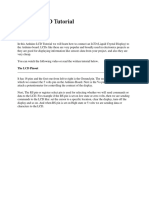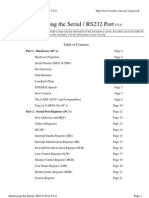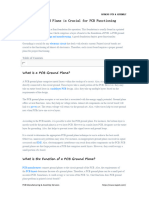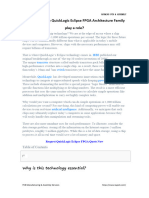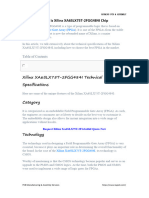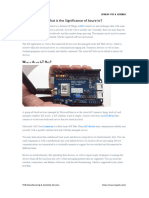How To Program Arduino FPGA
Uploaded by
jackHow To Program Arduino FPGA
Uploaded by
jackRAYMING PCB & ASSEMBLY
How to program Arduino FPGA
From the growing Internet of Things to the arrival of artificial intelligence,
field-programmable gate arrays are steadily making their way into the
future of electronics. Field-programmable gate array development is
getting increasingly popular across various sectors and applications due to
its versatility and constantly declining cost. However, as gadgets grow
smaller and more linked, some may be difficult to use, making
development impractical. On the other hand, field-programmable gate
arrays are frequently helpful in developing devices, so using a link to
control the device from a distance might be advantageous.
FPGAs are ICs programmed to carry out a predetermined set of tasks.
Because they are programmable, we can modify FPGAs to suit the unique
requirements of various applications. On the other hand, Arduino is
a microcontroller board created for quick and interactive electronics
prototyping. Its open-source infrastructure accommodates a variety of
initiatives.
Table of Contents
FPGAs
PCB Manufacturing & Assembly Services https://www.raypcb.com/
RAYMING PCB & ASSEMBLY
A digital circuit known as an FPGA can carry out any logical operation.
PLBs, or programmable logic blocks, are the building blocks of FPGAs and
we can combine them to form any digital circuit. The PLB can produce a
variety of logical functions, including AND, OR, XOR, and NOT gates.
Furthermore, the PLBs can be suitable for maths operations and other
tasks like memory storage.
The advantages of FPGAs over conventional digital circuits are numerous.
Secondly, FPGAs are flexible and adaptable to various applications
because we can reprogram the. Second, because FPGAs can carry out
many tasks, they can take the role of various digital circuits. Third,
complicated digital circuits that are not feasible with conventional digital
circuits can consist of FPGAs.
Arduino
A microcontroller board called Arduino is ideal for quick and interactive
electronics prototyping. Arduino software programs the microprocessor
at the heart of Arduino boards. The libraries and tools included with the
Arduino software make it simple to write and upload code to the
microcontroller. In addition, the input and output pins of Arduino boards
can connect to sensors, actuators, and other electronic devices.
PCB Manufacturing & Assembly Services https://www.raypcb.com/
RAYMING PCB & ASSEMBLY
Anyone without an electronics background can easily develop their
projects with Arduino hardware and software. Moreover, because of their
low cost and simplicity of use, Arduino boards are also well-liked among
students and hobbyists.
Request PCB Manufacturing & Assembly Quote Now
Connecting an FPGA to an Arduino Board
arduino FPGA PCBA
Connecting the two parts is the first step in using an FPGA with an Arduino.
The connection technique will vary depending on the specific FPGA and
Arduino boards utilized. There are typically two ways to link an FPGA to an
Arduino:
GPIO Pins: Using the General Purpose Input/Output (GPIO) pins on
the Arduino board is the simplest method for connecting an FPGA to an
Arduino. Several GPIO pins on most Arduino boards can interface with
external electronics. First, determine the precise pins on both the Arduino
PCB Manufacturing & Assembly Services https://www.raypcb.com/
RAYMING PCB & ASSEMBLY
and the FPGA that will be helpful for communication if you want to link an
FPGA to an Arduino utilizing GPIO pins. Once you’ve located these pins,
you can link them with pins or a unique PCB.
Shields: Using a shield is another way to link an FPGA to an Arduino. The
capability of the Arduino board can increase by attaching Arduino shields,
which are pre-built modules. A variety of FPGA shields are available for
use in securing an FPGA to an Arduino. The ports on these shields often
enable direct connection of the FPGA to the Arduino board.
Steps of programming Arduino FPGA
The Arduino FPGA is a versatile platform for designing and
programmatically manipulating unique hardware circuits. You may create
intricate digital systems with an FPGA that carry out particular operations,
such as data processing, signal filtering, and control logic.
By utilizing a hardware description language (HDL) to create a hardware
design, synthesizing the design into a bitstream, and uploading the
bitstream to the FPGA chip, you can program an Arduino FPGA. Below is a
thorough breakdown of each action.
Step 1: Install the Necessary Software and Hardware
PCB Manufacturing & Assembly Services https://www.raypcb.com/
RAYMING PCB & ASSEMBLY
Setting up your development environment is necessary before you can
begin writing code for an Arduino FPGA. This entails connecting the
Arduino FPGA board to your computer and installing the required
software programs, such as an HDL compiler, synthesis tool, and FPGA
programmer.
The Xilinx Vivado development suite, used for FPGA design and synthesis,
is included in the thorough instructions on setting up your environment
and installing the software available on the Arduino website. The next step
can be after you have connected your Arduino FPGA board and installed
the software.
Install the Arduino IDE after downloading it: You will develop and upload
your code to the FPGA board using the Arduino Integrated Development
Environment. You can download the most recent version of the Arduino
IDE at the official Arduino website.
After installing the Arduino IDE, you must install the FPGA board support
package. This package contains the files and libraries required
for programming the FPGA board. By selecting “Board” from the Arduino
IDE’s “Tools” menu, followed by “Boards Manager,” you can install the
board support package. Find the FPGA board you’re using in the Boards
Manager, then select “Install.”
PCB Manufacturing & Assembly Services https://www.raypcb.com/
RAYMING PCB & ASSEMBLY
Connecting Your PC to the FPGA Board: Use a USB cord to link the FPGA
board to your PC. Your computer ought to recognize the board right away.
Step 2: Create a Hardware Design
The following stage is to develop an FPGA hardware design using an HDL,
such as Verilog or VHDL. To build and simulate complicated digital
systems using software tools, HDL describes the behavior and topology of
digital circuits textually.
A text editor or an integrated development environment (IDE) that
supports HDLs, such as Xilinx Vivado or Quartus II, can generate a
hardware design. The circuit’s inputs, outputs, and functionality, as well as
the connections and logic gates that carry it out, are defined throughout
the design process.
After creating your hardware design, save it as a Verilog or VHDL file for
the next stage.
Step 3: Write and Compile the Code
You can begin writing the code after designing and simulating the circuit.
To create your code in the C++ programming language, utilize the Arduino
IDE. The code should contain all the essential commands to control the
PCB Manufacturing & Assembly Services https://www.raypcb.com/
RAYMING PCB & ASSEMBLY
various elements in your circuit, such as turning on and off LEDs or
adjusting a motor’s speed.
You must compile the code after writing it to ensure no problems. A
built-in compiler in the Arduino IDE verifies the code for syntax errors and
other problems. Before going on to the next step, you must correct any
mistakes.
Step 4: Upload the Program to the FPGA
You can upload the program to the FPGA after compiling it. The steps
listed below will assist you in uploading the program:
Join the FPGA board and the J-Link programmer.
Use a USB cable to link the FPGA board to your PC.
In the Arduino IDE, select Sketch > Upload Using Programmer.
Hold off till the upload procedure is complete.
Remove the USB cord and J-Link programmer from the FPGA board.
Step 5: Test the Program on the FPGA
Testing the software after uploading it to the FPGA is crucial to ensure
everything is operating as it should. To test the program on the FPGA,
perform these steps:
PCB Manufacturing & Assembly Services https://www.raypcb.com/
RAYMING PCB & ASSEMBLY
Attach the input and output devices to the FPGA board: Sensors, motors,
LEDs, and any other components the program interacts with can serve as
input and output devices. Attach these gadgets to the proper FPGA board
pins.
The FPGA board is powered by: Use a USB cable or an
external power supply to attach the FPGA board to a power source.
Check the output on the linked devices: After connecting the input devices
and turning on the FPGA, check the output on the connected devices to
ensure the program is operating as intended. Confirm if the motor is
spinning in the right direction and speed, for instance, if the program is to
control a motor. Ensure the accuracy of the readings if the program is to
read data from a sensor.
Make any alterations required: Go over the code to find any problems if
the program is not functioning as it should. You might need to make
changes to the code to correct any errors or improve performance.
Test the program using numerous inputs and scenarios: To completely
test the software, use various inputs and scenarios to ensure it functions
appropriately in various situations. For instance, test the program with
various temperatures to manage a temperature sensor to ensure data
reads correctly.
PCB Manufacturing & Assembly Services https://www.raypcb.com/
RAYMING PCB & ASSEMBLY
Iterate and enhance: After testing the program, make any necessary
adjustments to enhance its functionality or performance. Then, keep
testing and iterating until the programme satisfies all requirements and
functions as intended.
Request PCB Manufacturing & Assembly Quote Now
Programming language used
Arduino
The Arduino programming language, a simplified version of C++ designed
for beginners, is commonly used to create applications for the Arduino
platform. For example, writing code for microcontrollers like
the ATmega328P found in the Arduino Uno board is made simple with this
language.
PCB Manufacturing & Assembly Services https://www.raypcb.com/
RAYMING PCB & ASSEMBLY
As opposed to this, FPGAs (Field Programmable Gate Arrays) are often
programmed using HDLs like VHDL or Verilog. With these languages, you
can describe hardware circuit behavior in a manner akin to how you
would describe a software algorithm.
Yet some FPGAs also support high-level programming in C or C++, which
we subsequently convert by a compiler into the low-level hardware
description language. For people who are more accustomed to software
programming, this method, commonly called high-level synthesis (HLS),
can make it simpler to design FPGA applications.
While Verilog and VHDL are used to describe the behavior of digital
circuits, their syntax and semantics are dissimilar. A brief description of
each language is below:
Verilog:
In the 1980s, Prabhu Goel and Phil Moorby created Verilog, a high-level
HDL. It is frequently helpful for digital design and verification. It has a
syntax comparable to C. Modules, which are similar to the components of
digital circuits, and are the building blocks of Verilog code. Complex digital
systems can be built by instantiating and connecting these modules: many
FPGA vendors and the semiconductor industry support Verilog.
VHDL:
PCB Manufacturing & Assembly Services https://www.raypcb.com/
RAYMING PCB & ASSEMBLY
The US Department of Defense created VHDL, also known as VHSIC
Hardware Description Language, in the 1980s. We describe digital circuits
and systems using this high-level HDL. One can create and couple the
modules of VHDL code together to form intricate digital systems. Although
VHDL’s syntax is more complicated than Verilog’s, it is more capable and
expressive. As a result, most FPGA vendors support it, which is frequently
helpful in safety-critical applications.
Because they enable you to describe digital circuits and systems abstractly,
Verilog and VHDL are both utilized for FPGA programming. This makes
designing and debugging digital circuits simpler, especially for intricate
systems. Moreover, most FPGA suppliers offer Verilog and VHDL, and both
have sizable toolchains and libraries available.
Request PCB Manufacturing & Assembly Quote Now
Examples of projects that use an FPGA with an Arduino
PCB Manufacturing & Assembly Services https://www.raypcb.com/
RAYMING PCB & ASSEMBLY
While Arduinos are microcontrollers created to offer a simple platform for
creating interactive projects, FPGAs are strong devices that may help to
implement specialized digital logic circuits. A powerful system that
combines the programmability and flexibility of an FPGA with the usability
and accessibility of an Arduino can come about by combining an FPGA
with an Arduino.
FPGA-based audio processing
Practicing FPGAs for real-time digital signal processing (DSP) algorithms to
handle audio signals is common. This is known as FPGA-based audio
processing. The FPGA can perform filtering, equalization, compression,
and many more tasks. The fundamental actions involved in FPGA-based
audio processing are listed below:
Audio signal input: The FPGA may receive the audio signal by
utilizing an ADC to collect it. The ADC can connect to the FPGA via a
serial interface like SPI or I2C.
Algorithms for processing: The FPGA can run different DSP
algorithms on the audio signal input. Hardware description
languages such as VHDL or Verilog can help implement these
algorithms.
Memory: The FPGA can have internal or external memory to hold
the edited audio samples.
PCB Manufacturing & Assembly Services https://www.raypcb.com/
RAYMING PCB & ASSEMBLY
Export audio signal: A digital-to-analog converter can output the
processed audio signal (DAC). The DAC can link to the FPGA via a
serial interface like SPI or I2C.
Control interface: A user interface for controlling the audio
processing algorithms can use an Arduino or another
microcontroller. Other devices like sensors, buttons, and displays
can receive input and output from the Arduino.
FPGA-based video processing:
Although technically possible, FPGA-based video processing with Arduino
is not simple. Field programmable gate arrays, sometimes FPGAs, are
extremely flexible integrated circuits that may carry out particular tasks.
Because of their quick processing times and low power requirements,
they are frequently helpful in video processing applications.
A popular microcontroller platform for do-it-yourself electronics projects
is Arduino. It can be helpful to manage an FPGA handling video processing
even if it is unsuitable for high-speed video processing.
You would need to:
Choose an FPGA board compatible with the Arduino to implement
FPGA-based video processing using an Arduino. Various FPGA
PCB Manufacturing & Assembly Services https://www.raypcb.com/
RAYMING PCB & ASSEMBLY
boards, like the Papilio DUO and the Mojo V3, may be controlled by
an Arduino.
Create code in Verilog or VHDL to instruct the FPGA to perform the
appropriate video processing task. For example, this might involve
video compression, color grading, or image scaling.
Employ a communication standard like SPI or I2C to communicate
data and commands from the Arduino to the FPGA. The FPGA can
receive inputs from the Arduino through visual data or control
signals.
Attach the FPGA board to the video input source and output display.
The video data will be real-time processed by the FPGA, and the
output will go to the display device.
A complex project requiring a thorough knowledge of digital circuit design,
programming, and video processing algorithms, it is essential to keep in
mind that implementing FPGA-based video processing using an Arduino.
Nonetheless, it can be a fruitful endeavour that yields a high-performance
video processing system with the correct knowledge and tools.
FPGA-based data acquisition
A high-speed data acquisition system that can sample analog signals with
high precision and store the data in memory can happen using an FPGA.
The Arduino can link with sensors and other devices to control the data
PCB Manufacturing & Assembly Services https://www.raypcb.com/
RAYMING PCB & ASSEMBLY
collecting process and send inputs to the FPGA. You can adhere to the
general steps listed below:
Use a hardware description language (HDL), such as Verilog or VHDL,
to design the FPGA-based data acquisition system. Creating the
proper input/output ports and building the logic circuits that will
interface with the sensors or other data sources you wish to collect
is required.
Use an FPGA development board, such as a Digilent Nexys or Basys
board, to implement the FPGA design. To compile and program the
FPGA, you must use a software toolchain like Xilinx ISE or Vivado.
Connect the Arduino and FPGA using an I2C or SPI communication
mechanism. By doing this, the Arduino can interface with the FPGA
and access the data the FPGA is capturing.
Create an Arduino program to show or save the data the FPGA
collects. The Arduino has built-in libraries and routines that can help
to show data on an LCD screen, save it to an SD card, or send it
wirelessly over Bluetooth or Wi-Fi.
Generally, FPGA-based data acquisition systems can be more flexible and
performant than conventional microcontroller-based systems, but they
also need more design and implementation resources and technical
PCB Manufacturing & Assembly Services https://www.raypcb.com/
RAYMING PCB & ASSEMBLY
know-how. If you’ve never programmed an FPGA, you might wish to start
with easier projects and gradually advance your abilities.
Request PCB Manufacturing & Assembly Quote Now
Implications of Arduino FPGA for future projects and research
Integrating Field-Programmable Gate Arrays (FPGAs) with Arduino
microcontrollers has several consequences for upcoming projects and
research. For example, digital circuits known as FPGAs may carry out
particular jobs or operations. Furthermore, for creating projects using
sensors, actuators, and other electrical components, Arduino is a popular
open-source electronics platform.
Increased Processing Power
Increased processing power is one of Arduino FPGA’s most important
effects. FPGAs can process data in parallel and execute complicated
PCB Manufacturing & Assembly Services https://www.raypcb.com/
RAYMING PCB & ASSEMBLY
operations in real-time. When paired with Arduino microcontrollers, the
resultant system can do more sophisticated tasks that would be
challenging or impossible for a microcontroller alone. Application areas
for FPGAs include machine learning, audio processing, and image
processing. Developers may build systems capable of performing intricate
computations and making real-time choices by integrating an FPGA with
an Arduino board.
Customizability
The customizable nature of Arduino FPGA is another result. FPGAs offer
incredible customizability and we may program it to carry out particular
actions or operations. This implies that the final system may change to
meet the unique requirements of the project or research. For instance, an
FPGA might help to create a unique encryption technique or to carry out
quick data compression. Developers may design systems optimized for
their unique requirements by employing an FPGA.
Real-Time Processing
FPGAs’ real-time data processing capabilities make them particularly
advantageous for applications like robotics, automation, and signal
processing. For instance, a robot’s motors may use an FPGA, and sensor
data could process in real time. In addition, developers may build systems
PCB Manufacturing & Assembly Services https://www.raypcb.com/
RAYMING PCB & ASSEMBLY
that can react to information in real time and make decisions based on
that input by attaching an FPGA to an Arduino board.
Low Latency
By combining Arduino with FPGA, low-latency systems that process data in
real-time and react swiftly to input can be created. For instance, a
developer may utilise an FPGA to construct a bespoke digital filter to
reduce noise from a sensor signal. The system created by combining an
FPGA with an Arduino board can react fast to changes in the sensor signal
and deliver a low-latency output.
Education
There may be educational ramifications to the FPGA and Arduino
connection. For example, students may get knowledge of digital logic and
programming and hands-on experience with digital circuit applications by
utilizing an FPGA. In addition, students may also access various
instructional materials, like tutorials, sample projects, and reference
designs, thanks to the open-source nature of both Arduino and FPGAs.
Request PCB Manufacturing & Assembly Quote Now
Limitations of using an FPGA with an Arduino
PCB Manufacturing & Assembly Services https://www.raypcb.com/
RAYMING PCB & ASSEMBLY
Powerful digital devices known as FPGAs (Field-Programmable Gate Arrays)
may be helpful for various functions. Conversely, Arduino is a
microcontroller board frequently essential for DIY projects and quick
prototyping. However, there are several restrictions to take into account,
even if utilizing an FPGA with an Arduino can be a wonderful method to
combine the processing power of the FPGA with the adaptability and
simplicity of the Arduino:
FPGAs are more complicated than microcontrollers like Arduino in terms
of complexity. FPGAs need expertise in digital design, and specific
hardware and software are necessary to program them. Due to its
intricacy, it may be difficult for novices to utilize an FPGA with an Arduino.
Power: Compared to microcontrollers, FPGAs consume more power. This
means a more complex power supply may be necessary for an FPGA with
an Arduino than an Arduino acting alone.
FPGAs are larger than microcontrollers in terms of size. If space is a
limitation, as it often is with tiny projects or wearables, this can be a
problem.
Cost: Compared to microcontrollers, FPGAs are often more costly. This can
be a problem if your budget is minimal.
PCB Manufacturing & Assembly Services https://www.raypcb.com/
RAYMING PCB & ASSEMBLY
Not all FPGAs are suitable for use with Arduino boards. Ensure the FPGA
you select is compatible with the Arduino board you intend to use.
Learning curve: FPGA programming requires a distinct set of skills
than microcontroller programming. Learning the skills necessary to
program an FPGA can be time-consuming, and some people may have a
high learning curve.
Combining an FPGA with an Arduino can be effective, but doing so
requires more work and expertise than utilizing an Arduino alone.
However, you can use an FPGA’s flexibility and power if you’re ready to
invest the time and money needed to learn how to use it.
Related Posts:
1. How to program, Architecture, and applications of Lattice FPGA
2. Which is the best to use between Arduino Leonardo and Arduino
UNO
3. CYUSB3014-BZXC: An Application-Specific Microcontroller with
External Program Memory
4. What is the difference between Xilinx FPGA and Altera FPGA?
https://www.raypcb.com/arduino-fpga/
PCB Manufacturing & Assembly Services https://www.raypcb.com/
You might also like
- Multitasking With Raspberry Pi by Dogan Ibrahim100% (2)Multitasking With Raspberry Pi by Dogan Ibrahim232 pages
- Free Ebook To Learn and Design Your Own Microcontroller Projects100% (2)Free Ebook To Learn and Design Your Own Microcontroller Projects111 pages
- Arduino - How To Control Servo Motor With Potentiometer - 5 Steps (With Pictures) - InstructablesNo ratings yetArduino - How To Control Servo Motor With Potentiometer - 5 Steps (With Pictures) - Instructables7 pages
- Reading PWM Signals From An RC Receiver With ArduinoNo ratings yetReading PWM Signals From An RC Receiver With Arduino4 pages
- Arduino Starter Kit Experiment Manual v2.0.0 1No ratings yetArduino Starter Kit Experiment Manual v2.0.0 1111 pages
- GSM Alarm System Using Arduino and A PIR SensorNo ratings yetGSM Alarm System Using Arduino and A PIR Sensor7 pages
- A Short and Simple Guide To Bootloading The Attiny-85 or 45100% (3)A Short and Simple Guide To Bootloading The Attiny-85 or 454 pages
- ESP-WROOM-02: What Is The "Internet of Things"?100% (2)ESP-WROOM-02: What Is The "Internet of Things"?7 pages
- Atmel 42287 ATmega328P Xplained Mini User Guide - UserGuide PDF100% (3)Atmel 42287 ATmega328P Xplained Mini User Guide - UserGuide PDF19 pages
- ESP32 SIM800L Publish Data to Cloud without Wi-Fi Random Nerd Tutorials100% (1)ESP32 SIM800L Publish Data to Cloud without Wi-Fi Random Nerd Tutorials102 pages
- Microcontroller Based Inductance Capacitance Meter: Mudit Agarwal100% (1)Microcontroller Based Inductance Capacitance Meter: Mudit Agarwal5 pages
- Interfacing LCD To Arduino Display Text and Characters On LCD Screen Using Arduino100% (2)Interfacing LCD To Arduino Display Text and Characters On LCD Screen Using Arduino9 pages
- Acclerometer Based Gesture Controlled Robotic Arm ProjectNo ratings yetAcclerometer Based Gesture Controlled Robotic Arm Project22 pages
- 2014-05 - Circuit Cellar US - CC - Issue 286 MayNo ratings yet2014-05 - Circuit Cellar US - CC - Issue 286 May84 pages
- Arduino GSM Project Security Alert Message To Multiple Numbers100% (1)Arduino GSM Project Security Alert Message To Multiple Numbers7 pages
- How Is Arduino Uno Different From Other Available Microcontrollers?100% (1)How Is Arduino Uno Different From Other Available Microcontrollers?25 pages
- The 74HC164 Shift Register and Your Arduino100% (2)The 74HC164 Shift Register and Your Arduino13 pages
- Capacitor Meter AutoRanging OLED 128x32 KTW Updated Code 05feb2021100% (1)Capacitor Meter AutoRanging OLED 128x32 KTW Updated Code 05feb20212 pages
- Arduino Rotary Encoder Menu - Educ8s.tv - Watch Learn BuildNo ratings yetArduino Rotary Encoder Menu - Educ8s.tv - Watch Learn Build17 pages
- How To Use Matlab and Simulink With ArduinoNo ratings yetHow To Use Matlab and Simulink With Arduino16 pages
- Smart Car Manual Ultrasonic Obstacle AvoidanceNo ratings yetSmart Car Manual Ultrasonic Obstacle Avoidance30 pages
- Arm Case-Study: The Raspberry Pi: Razvan Bogdan Microprocessor Systems100% (2)Arm Case-Study: The Raspberry Pi: Razvan Bogdan Microprocessor Systems115 pages
- Programming and Interfacing The 8051 Microcontroller0% (2)Programming and Interfacing The 8051 Microcontroller9 pages
- Instant ebooks textbook STM32 IoT Projects for Beginners: A Hands-On Guide to Connecting Sensors, Programming Embedded Systems, Build IoT Devices with STM32 1st Edition Aharen San download all chapters100% (2)Instant ebooks textbook STM32 IoT Projects for Beginners: A Hands-On Guide to Connecting Sensors, Programming Embedded Systems, Build IoT Devices with STM32 1st Edition Aharen San download all chapters40 pages
- Uno Easy Starter Project: LED Cube Arduino Uno Building and Coding Project 3 Beginners Edition Ebonygeek45From EverandUno Easy Starter Project: LED Cube Arduino Uno Building and Coding Project 3 Beginners Edition Ebonygeek455/5 (1)
- Uno Programming digitalWrite: Beginners Edition S O S ProjectFrom EverandUno Programming digitalWrite: Beginners Edition S O S ProjectNo ratings yet
- Deep Learning on Microcontrollers: Learn how to develop embedded AI applications using TinyML (English Edition)From EverandDeep Learning on Microcontrollers: Learn how to develop embedded AI applications using TinyML (English Edition)5/5 (1)
- Why Non Recurring Engineering Cost (NRE Charge) Is Important For Your PCBNo ratings yetWhy Non Recurring Engineering Cost (NRE Charge) Is Important For Your PCB4 pages
- Why You Should Choose The Shengyi S7439G PCB MaterialNo ratings yetWhy You Should Choose The Shengyi S7439G PCB Material5 pages
- Xilinx XAZU2EG-1SBVA484I Fpga ApplicationNo ratings yetXilinx XAZU2EG-1SBVA484I Fpga Application5 pages
- Why Is The Home Energy Monitor ImportantNo ratings yetWhy Is The Home Energy Monitor Important7 pages
- Why The Arlon 49N PCB Material Is Useful in High Temperature or High Performance ApplicationsNo ratings yetWhy The Arlon 49N PCB Material Is Useful in High Temperature or High Performance Applications4 pages
- Why Is The Panasonic R-F705S Useful For Mobile and Automotive ProductsNo ratings yetWhy Is The Panasonic R-F705S Useful For Mobile and Automotive Products4 pages
- Why OEM Circuit Boards Are Ideal For Use in Several ApplicationsNo ratings yetWhy OEM Circuit Boards Are Ideal For Use in Several Applications6 pages
- Where To Buy Rogers RT Duroid 5880 LaminateNo ratings yetWhere To Buy Rogers RT Duroid 5880 Laminate5 pages
- Who Are The Leading Electrical Coil ManufacturersNo ratings yetWho Are The Leading Electrical Coil Manufacturers5 pages
- Why A PCB Ground Plane Is Crucial For PCB FunctioningNo ratings yetWhy A PCB Ground Plane Is Crucial For PCB Functioning3 pages
- What Is The Significance of IOT in AgricultureNo ratings yetWhat Is The Significance of IOT in Agriculture8 pages
- Why 3D Print PCBs Matter in Today's Electronics ProductionNo ratings yetWhy 3D Print PCBs Matter in Today's Electronics Production4 pages
- What Is The Significance of Home Electronics PCBNo ratings yetWhat Is The Significance of Home Electronics PCB6 pages
- Where Does The QuickLogic Eclipse FPGA Architecture Family Play A RoleNo ratings yetWhere Does The QuickLogic Eclipse FPGA Architecture Family Play A Role11 pages
- What Is The Significance of ENIG Plating ThicknessNo ratings yetWhat Is The Significance of ENIG Plating Thickness4 pages
- What Is Xilinx Spartan-7 Its Datasheet and Reference DesignsNo ratings yetWhat Is Xilinx Spartan-7 Its Datasheet and Reference Designs20 pages
- What Is Signal Integrity A Comprehensive OverviewNo ratings yetWhat Is Signal Integrity A Comprehensive Overview9 pages
- What Is The Purpose and Applications of A PCB MotherboardNo ratings yetWhat Is The Purpose and Applications of A PCB Motherboard4 pages
- What Is The Difference Between ARM and FPGA ProcessorsNo ratings yetWhat Is The Difference Between ARM and FPGA Processors9 pages
- What Is SMT Soldering Process Step by StepNo ratings yetWhat Is SMT Soldering Process Step by Step12 pages
- What Is The Difference Between Clean Flux and No Clean Flux Off PCBNo ratings yetWhat Is The Difference Between Clean Flux and No Clean Flux Off PCB13 pages
- What Is Xilinx Kintex UltraScale UltraScale+No ratings yetWhat Is Xilinx Kintex UltraScale UltraScale+8 pages
- What Is Thermal Consideration in PCB DesignNo ratings yetWhat Is Thermal Consideration in PCB Design6 pages
- What Is The Difference Between FFC Connector and FPC ConnectorNo ratings yetWhat Is The Difference Between FFC Connector and FPC Connector14 pages
- Powermax105 Operator Manual 807390 EnglishNo ratings yetPowermax105 Operator Manual 807390 English162 pages
- 3ADW000192R0401 DCS800 Technical Catalog e DNo ratings yet3ADW000192R0401 DCS800 Technical Catalog e D28 pages
- CSE 315 Microprocessors & Microcontrollers: Tanvir Ahmed KhanNo ratings yetCSE 315 Microprocessors & Microcontrollers: Tanvir Ahmed Khan38 pages
- Microgrids A Review of Modeling Control Protection Simulation and Future PotentialNo ratings yetMicrogrids A Review of Modeling Control Protection Simulation and Future Potential7 pages
- Bis C-6002-019-650-03-Kl2 Order Code: Bis0099: LF (70/455 KHZ)No ratings yetBis C-6002-019-650-03-Kl2 Order Code: Bis0099: LF (70/455 KHZ)3 pages
- Radu Bojan: Passion For Perfection in Design and ManufactureNo ratings yetRadu Bojan: Passion For Perfection in Design and Manufacture9 pages
- KRC-208S KRC-218 KRC-28MR: Instruction Manual Mode D'Emploi Manual de Instrucciones Manual de InstruçõesNo ratings yetKRC-208S KRC-218 KRC-28MR: Instruction Manual Mode D'Emploi Manual de Instrucciones Manual de Instruções25 pages
















































